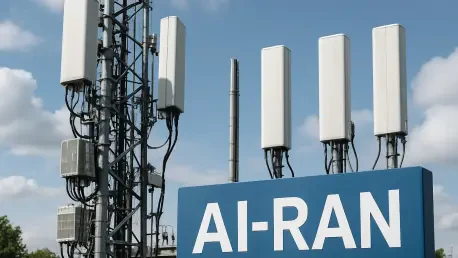Setting the Stage for a Connectivity Revolution
Imagine a world where mobile networks not only keep up with skyrocketing data demands but also predict and adapt to them in real time, slashing latency and powering futuristic applications like autonomous vehicles. This isn’t a distant dream—it’s the reality being shaped by Artificial Intelligence-Radio Access Network (AI-RAN), a transformative force in telecommunications. As mobile data traffic continues to explode, with global projections estimating a market for AI and RAN traffic optimization reaching $27.2 billion by 2034, the industry stands at a pivotal moment. This market analysis delves into how AI-RAN is redefining mobile network performance, exploring current trends, data-driven insights, and future growth trajectories. The focus is on understanding how this technology addresses critical pain points for providers and enterprises while unlocking new revenue streams in an increasingly competitive landscape.
Diving Deep into Market Dynamics and Forecasts
Unpacking AI-RAN’s Role in Network Optimization
AI-RAN is rapidly emerging as a cornerstone of mobile network efficiency, leveraging artificial intelligence to revolutionize resource management. Unlike traditional radio access networks that depend on static configurations, AI-RAN employs predictive algorithms to dynamically allocate spectrum and bandwidth, ensuring seamless performance in high-traffic scenarios. Market data highlights a surging demand for such intelligent systems, with investments in AI-driven network solutions expected to grow significantly over the next decade. This trend is driven by the need to reduce latency and enhance reliability, especially in urban centers where network congestion is a persistent challenge.
The implications for cellular providers are profound, as optimized operations translate directly into cost savings and improved customer satisfaction. Early adopters in densely populated regions have already reported fewer dropped connections and faster data speeds, setting a benchmark for competitors. However, the market faces hurdles, including the high initial costs of integrating AI into existing infrastructure and ensuring data quality for accurate predictions. Despite these challenges, the trajectory points toward widespread adoption as the technology matures and costs decline.
Edge Computing as a Catalyst for New Services
Another key market trend is AI-RAN’s ability to enable cutting-edge services through edge computing, processing data closer to its source rather than relying on centralized clouds. This capability is unlocking opportunities for low-latency applications critical to industries such as healthcare, automotive, and industrial automation. For instance, real-time analytics for self-driving cars and remote medical procedures are becoming viable, creating niche markets with high growth potential. Analysts predict that edge-based AI services could become a significant revenue driver for providers, with enterprise demand fueling innovation.
The competitive advantage lies in offering tailored solutions like network slicing, where specific bandwidth is reserved for mission-critical applications. Yet, this segment of the market must navigate security concerns, as distributed data processing raises risks of breaches at multiple points. Providers who can address these vulnerabilities while scaling edge services stand to capture substantial market share. The balance between innovation and risk management will shape the pace of growth in this domain over the coming years.
Infrastructure Shifts and Regional Market Variations
AI-RAN’s market impact is also tied to infrastructure transformation, with a shift toward cloud-native, scalable systems using commercial off-the-shelf servers and hardware accelerators like GPUs. This aligns with Open RAN (O-RAN) standards, promoting interoperability and reducing reliance on proprietary hardware. In advanced markets like North America and Europe, adoption is accelerating due to robust existing cloud frameworks and industry collaboration through groups like the AI-RAN Alliance. Market forecasts suggest these regions will lead in deployment, with significant capital expenditure directed toward AI-RAN integration by 2027.
Conversely, emerging economies face barriers due to limited access to necessary hardware and expertise, slowing market penetration. Small-scale pilots in smart city projects offer a pathway to build capacity, but disparities in infrastructure readiness create a fragmented global market. Regulatory environments further complicate the landscape, as policies on data governance and spectrum allocation vary widely. Stakeholders must tailor strategies to regional realities, balancing investment risks with the long-term potential of untapped markets.
Future Growth Tied to 6G and AI-Native Networks
Looking ahead, AI-RAN is positioned as a foundational element for 6G networks, with market predictions indicating a full integration of AI into network design by the early 2030s. This shift toward AI-native systems promises self-healing networks and ultra-low latency, opening doors to immersive technologies like virtual reality and smart infrastructure. Technological advancements, such as digital twin simulations for testing AI models, are already influencing development pipelines, while economic decisions—whether to build or rent computational resources—will determine rollout speed.
The market for 6G-enabled AI-RAN solutions is expected to create new competitive dynamics, with providers vying to establish early leadership. Regulatory frameworks around data privacy and spectrum management could either catalyze or constrain growth, depending on how policymakers adapt to technological realities. As enterprises increasingly demand intelligent connectivity, the market will likely see a surge in partnerships between providers and hyperscalers to deliver scalable solutions. This convergence signals a transformative phase for telecommunications, with AI-RAN at its core.
Reflecting on Market Insights and Strategic Pathways
Looking back, this analysis illuminates how AI-RAN reshapes mobile network markets by enhancing performance, enabling edge-based services, and laying the groundwork for 6G. The journey reveals stark regional disparities and infrastructure challenges that temper adoption rates, yet the overarching trend points to robust growth fueled by enterprise demand and technological innovation. Providers who navigate security and scalability concerns gain early footholds in a competitive arena.
Moving forward, strategic action becomes imperative for stakeholders aiming to capitalize on this momentum. Investing in pilot projects to test AI-RAN compatibility with existing systems emerges as a prudent first step, minimizing risks while building expertise. Enterprises are encouraged to explore edge computing applications, targeting specific industry needs like real-time logistics or personalized retail solutions. Collaboration with technology partners to secure high-quality data and robust security protocols proves essential. Ultimately, aligning with O-RAN standards and anticipating regulatory shifts offers a roadmap to not just adapt but thrive in an era of intelligent connectivity.









